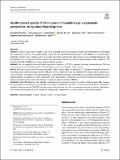| dc.contributor.author | Beaulieu, Elizabeth | |
| dc.contributor.author | Spanjaart, Anne | |
| dc.contributor.author | Roes, Ashley | |
| dc.contributor.author | Rachet, Bernard | |
| dc.contributor.author | Dalle, Stéphane | |
| dc.contributor.author | Kersten, Marie J. | |
| dc.contributor.author | Maucort-Boulch, Delphine | |
| dc.contributor.author | Jalali, Mohammad S. | |
| dc.date.accessioned | 2022-06-06T19:40:12Z | |
| dc.date.available | 2022-03-21T12:54:10Z | |
| dc.date.available | 2022-06-06T19:40:12Z | |
| dc.date.issued | 2022-03 | |
| dc.date.submitted | 2022-02 | |
| dc.identifier.issn | 1573-2649 | |
| dc.identifier.issn | 0962-9343 | |
| dc.identifier.uri | https://hdl.handle.net/1721.1/141314.2 | |
| dc.description.abstract | Abstract
Purpose
System science offers a unique set of tools, including causal loop diagrams (CLDs), for stakeholders to better grasp the complexity of factors surrounding quality of life. Because the health-related quality of life (HRQoL) of cancer immunotherapy patients exists within an intricate system affected by and affecting many factors across multiple dimensions, the development of a systems-level model can provide a powerful framework to aid the understanding of this complexity. We developed a CLD for HRQoL of cancer immunotherapy patients.
Methods
We first applied a literature-based approach to construct a CLD for patients following immunotherapy. We then iteratively reviewed and enhanced the CLD through interviews with subject matter experts.
Results
Based on the reviewed literature and subject matter expert input, we produced a CLD representing the system surrounding cancer immunotherapy patients’ HRQoL. Several feedback loops are identified that span clinical experiences, oncology teams’ perceptions about immunotherapy, social support structures, and further research and development in cancer immunotherapy, in addition to other components. The CLD enables visualization of thought experiments regarding how a change anywhere in the system can ultimately worsen or improve patients’ HRQoL.
Conclusion
The CLD illustrates the valuable contribution of a systems perspective to quality-of-life research. This systems-based qualitative representation gives insight on strategies to inhibit harmful effects, enhance beneficial effects, and inherent tradeoffs within the system. The CLD identifies gaps in the literature and offers a communication tool for diverse stakeholders. Our research method provides an example for studying the complexities of quality of life in other health domains. | en_US |
| dc.publisher | Springer International Publishing | en_US |
| dc.relation.isversionof | https://doi.org/10.1007/s11136-022-03110-5 | en_US |
| dc.rights | Creative Commons Attribution | en_US |
| dc.rights.uri | https://creativecommons.org/licenses/by/4.0/ | en_US |
| dc.source | Springer International Publishing | en_US |
| dc.title | Health-related quality of life in cancer immunotherapy: a systematic perspective, using causal loop diagrams | en_US |
| dc.type | Article | en_US |
| dc.identifier.citation | Beaulieu, Elizabeth, Spanjaart, Anne, Roes, Ashley, Rachet, Bernard, Dalle, Stéphane et al. 2022. "Health-related quality of life in cancer immunotherapy: a systematic perspective, using causal loop diagrams." | en_US |
| dc.contributor.department | Sloan School of Management | |
| dc.relation.journal | Quality of Life Research | en_US |
| dc.eprint.version | Final published version | en_US |
| dc.type.uri | http://purl.org/eprint/type/JournalArticle | en_US |
| eprint.status | http://purl.org/eprint/status/PeerReviewed | en_US |
| dc.date.updated | 2022-03-20T04:15:13Z | |
| dc.language.rfc3066 | en | |
| dc.rights.holder | The Author(s) | |
| dspace.embargo.terms | N | |
| dspace.date.submission | 2022-03-20T04:15:13Z | |
| mit.license | PUBLISHER_CC | |
| mit.metadata.status | Authority Work Needed | en_US |
